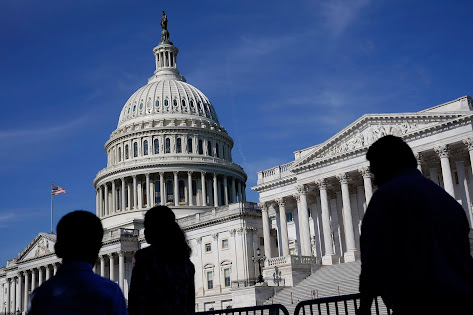Introduction
Amidst ongoing negotiations between President Joe Biden and top Republican lawmaker Kevin McCarthy, the United States is on the brink of reaching a deal on the contentious issue of the debt ceiling. Although details are still being finalized, sources familiar with the talks suggest that the agreement will likely be a concise framework rather than a lengthy bill. The focus will be on establishing key numbers for discretionary spending, while leaving the specifics of categories like housing and education to be worked out through the regular appropriations process. This article delves into the current state of negotiations, highlights the significance of discretionary spending, and explores the potential implications of the anticipated agreement.
Heading Towards a Slimmed-Down Agreement
Reports indicate that President Biden and Kevin McCarthy are inching closer to a compromise on the US debt ceiling, with the parties reportedly only $70 billion apart on discretionary spending. Instead of drafting an extensive bill, the negotiations are expected to produce a streamlined agreement comprising essential figures. By adopting this approach, lawmakers can avoid the time-consuming process of writing, reading, and voting on a comprehensive bill, allowing for a more expedited resolution.
Focus on Top Line Numbers
The primary objective of the negotiations is to establish top line numbers for discretionary spending, which includes crucial areas such as military funding. Discretionary spending accounted for $1.7 trillion in 2022, representing 27% of the overall $6.27 trillion expenditure, according to federal figures. Of this amount, approximately half was allocated to defense, an area that some lawmakers argue should not be subject to cuts. By determining these key figures, negotiators can set parameters for future budget talks and provide a foundation for further deliberations.
Leaving Fine Details for Future Consideration
While the negotiators aim to settle on top line numbers, the intricate details of specific spending categories, such as housing and education, are expected to be addressed through the regular appropriations process in the coming months. This approach allows for a more nuanced examination of these sectors, ensuring that funding is distributed appropriately and in accordance with the priorities set by lawmakers. By deferring the fine details to the regular appropriations process, the negotiators can maintain flexibility and accommodate the diverse needs and perspectives of various stakeholders.
Implications of the Agreement
The anticipated agreement on the debt ceiling would primarily serve as a mechanism to guide future budget negotiations. Rather than providing an exhaustive breakdown of spending, it would set guardrails and establish a framework for subsequent discussions. This approach allows for greater adaptability and responsiveness to evolving economic conditions and emerging priorities. The agreement is expected to bring a sense of stability and prevent a potential default, instilling confidence in financial markets.
Market Reactions
As news of progress on the debt limit negotiations emerged, the S&P 500 experienced a modest increase, while the prices of US Treasury bonds declined. Additionally, the US dollar reached its highest levels since March, signaling a positive market response to the more optimistic tone emanating from Washington. Investors and market participants are closely monitoring the developments, anticipating a resolution that would avert potential disruptions and ensure the smooth functioning of the economy.
Conclusion
As President Biden and Kevin McCarthy draw nearer to a deal on the US debt ceiling, the negotiations are expected to yield a concise agreement outlining top line numbers for discretionary spending. By focusing on essential figures, rather than delving into extensive details, lawmakers can expedite the resolution process. Leaving the specifics of categories like housing and education to the regular appropriations process allows for a more comprehensive examination of these sectors. The forthcoming agreement will provide guardrails for future budget talks and enhance economic stability, generating optimism among investors and market participants.






Social Plugin